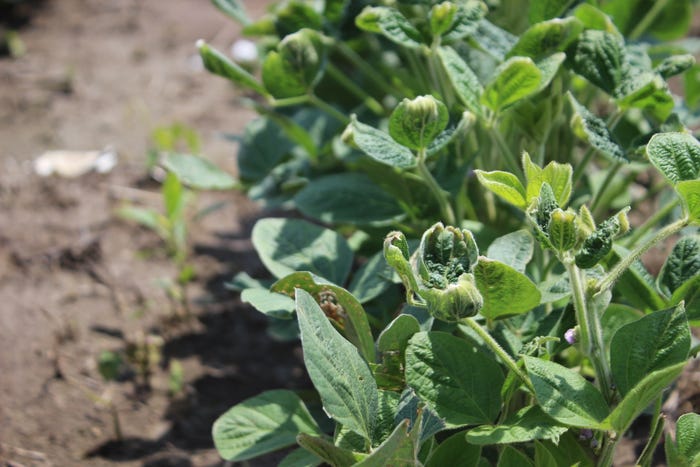
Jeremy Wolf didn’t plan on becoming a dicamba expert. In fact, he didn’t plant a single acre of Roundup Ready Xtend beans. Yet, after several of his soybean fields near Homer succumbed to off-target dicamba damage, he began learning more about the chemistry every day.
One of his biggest classrooms? Social media. Wolf took to social media to share his journey and to ask the ag industry for help determining what’s happening in his fields.
“Let’s investigate the unsuccessful applications, go around and follow up on complaints,” he says. “Let’s figure it out so we can make it right.”
Wolf spent the better part of three weeks in late June and early July investigating how his Liberty Link soybean fields were hit by off-target dicamba movement.
“It’s not fair to guys that are trying to use other technologies and get dinged for it,” he notes. “The time I’ve spent trying to track things down is unreal.” Wolf’s sleuthing efforts take up so much time that he hasn’t even had a chance to check all of his soybean fields. “I don’t have a solid (acre) count yet,” he notes.
After first discovering the dicamba-damaged soybeans, Wolf pulled out his plat book, contacted the land owners of surrounding fields and engaged in several uncomfortable conversations.
Wolf took to Twitter and recapped one conversation in a Periscope video, sharing how his neighbor applied Engenia according to label requirements, including the right nozzles, buffers, wind speeds and anti-drifting agents.
Follow up to the pics posted Friday after speaking with the neighboring farmer that sprayed Engenia https://t.co/VbWiDWeZa6
— Jeremy Wolf (@jwolf7447) July 9, 2017
Wolf’s investigation didn’t stop there. He contacted his retail applicator, independent agronomist Karen Corrigan and University of Illinois weed scientist Aaron Hager. Hager and Corrigan confirmed the chemical damage was caused by an off-target plant growth regulator, but said the symptoms didn’t match up with drift criteria, like damage on field edges. Puckered leaves spread across the entire field suggest tank contamination.
“From what I understand, it’s almost impossible to clean out of systems,” Wolf notes. He’s continuing to work with his retailer to understand more.
As one investigation took a turn, a new inquiry began when Wolf discovered another chemical-injured field.
New field. Top pic neighbor bottom mine. This one may be more challenging to figure out. Both fields surrounded by corn for 1/2mi. #dicamba pic.twitter.com/wGaZFpWiRM
— Jeremy Wolf (@jwolf7447) July 11, 2017
Wolf contacted neighboring farmers and asked what they sprayed and when. He still has one neighbor left to contact, but was confident the farmer didn’t plant Xtend soybeans based on prevoius conversations.
“I don’t know where it came from,” Wolf notes. “That’s what I’m scared of, though. People don’t want to be blamed or they don’t want to be in the public eye, but I hope they’re honest with you.”
Wolf filed an official pesticide incident complaint with the Illinois Department of Agriculture on July 12.
“There’s only so much time I can spend chasing this down,” he says. “It’s not something people want to do, and a lot are reluctant to do it because no one wants to risk the neighborhood. But if we want to be looked at with crediblity, we need to file one on every field we find. We don’t have a choice.”

UNEXPECTED SOUNDING BOARD: Wolf didn’t plant a single acre of Xtend soybeans, but farmers, retailers and agronomists are reaching out to Wolf privately, and publicly, as he shares his experience with off-target dicamba movement on social media.
More questions, fewer answers
It’s not just the “how” that stirs in the back of Wolf’s mind, it’s “What’s next?” He is already looking ahead at 2018 crop plans. “As a farmer, my job is risk management,” he notes. “How do I manage this risk?”
Herbicide-resistant weed challenges take Roundup Ready beans off the table and he’s hesitant to plant Liberty Link soybeans after this season’s crop injury issues. “And I’m not going to plant Xtend soybeans, spray dicamba products and run that risk,” he notes. “I’m seriously considering planting all corn next year.”
Agronomic decisions for next season lead Wolf back to figuring out what happened this season and determining potential yield loss on dicamba-injured beans.
“Don’t believe the advice you may hear about the crop being okay at harvest time,” Hager says. “What do you base that on? We don’t understand the exposure level is here. We have 50 years of data showing predictability effect is not that good. You have to remember this is a dose-dependent response.”
For now, Wolf tracks the off-target damage with pictures, social media posts and RGB drone images.
This is the #dicamba drift showing processed through @PrecisionHawk @_MrHyde @bobbyvick10 @TomUthell #spray17 #agtech pic.twitter.com/cpjUAWAX3l
— Jeremy Wolf (@jwolf7447) July 10, 2017
And he leans on independent agronomists, social media and university resources to nail down what went wrong when all signs point to on-label dicamba applications in surrounding fields.
Chem retailers,
— Jeremy Wolf (@jwolf7447) July 13, 2017
Anyone pulled samples from your lines while loading after Dicamba goes out to check for possible contamination issues?
Wolf acknowledges Xtend success stories and the farmers who effectively applied the new dicamba formulations without any issues. It’s the unexplainable damaged fields and the soybeans dinged by unidentified off-target dicamba that bother Wolf, and the crucial question, how much yield has he lost?
Yield damage showing from #Dicamba17 #soybeans pic.twitter.com/eDrtlTBdhv
— Jeremy Wolf (@jwolf7447) July 17, 2017
Pod damage showing itself from #Dicamba17 #spray17 pic.twitter.com/FS71vV9NpQ
— Jeremy Wolf (@jwolf7447) July 17, 2017
The great dicamba divide
The dicamba situation that has emerged over the past few weeks has multiple sides: the companies claiming off-label applications caused the majority of off-target movement, the farmers who are dealing with unexplainable off-target dicamba damage, the agronomists who are trying to help farmers navigate crop injuries, and the farmers who are defending their need for the technology.
The division amongst the ag community regarding in-season dicamba shocks Wolf. “I sure hope it’s not a precursor for what’s to come. That’s a scary road, pitting farmers against each other over technology,” he notes.
Wolf may have unwittingly opened a commentary floodgate by sharing his unfolding story on social media. Comments have come fast and furious as some folks defend the technology while others share their negative experience.
To those that say Dicamba damage is not real, come visit me. Top eight nodes now and not stopping. Out of control @weedgirl24 @PamSmithDTN pic.twitter.com/AcPU0CyyXT
— Jeremy Wolf (@jwolf7447) July 7, 2017
All the people I personally know with issues had it done by the book. just like your story. Stuff showing up still 3 weeks after app.
— Zane Jones (@zane_jones) July 11, 2017
.... what are you trying to say? We need this technology to combat the resistant weeds. It is here to say so we need to educate. #dicamba
— Jeff Herrold (@JeffHerrold) July 8, 2017
Plant more extend beans
— Gary Bahan (@gbahan) July 12, 2017
Wolf is surprised by the reactions and comments.
“What’s going on baffles me,” he notes. “If this is what ag is going to be, maybe farming is not my route.”
For now, his search for answers continues and he waits for an official IDOA pesticide complaint investigation.
We may all need the technology soon. We need to address the issues instead of burying them. Will only happen if we all talk open & honestly
— Jeremy Wolf (@jwolf7447) July 9, 2017
About the Author(s)
You May Also Like




